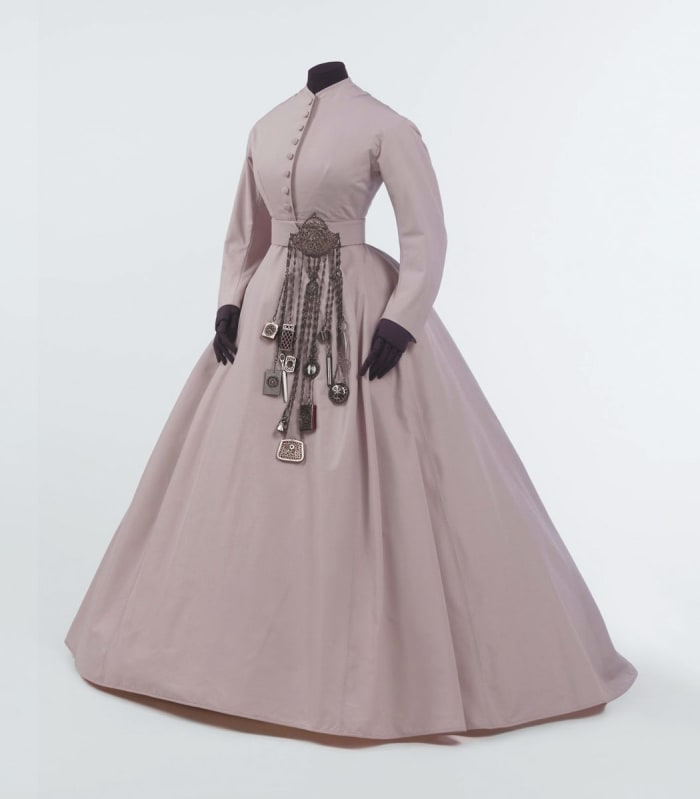#Chatelaines #Swiss #Army #Knife #Victorian #Fashion #Accessories
When a Victorian woman (let’s call her Clara) was doing housework around her English manor one day in the 19th century, she noticed that a button was coming loose on her blouse. She reached for the small sewing kit hanging at her waist and mended it lickety-split.
Making afternoon tea, she saw the sugar supply was running low, so she reached for a tiny notebook and jotted down a reminder to buy more. When she got a splinter, she grabbed a magnifying glass and easily plucked it out of her finger. That night when Clara went to check on her oldest daughter and a gentleman caller in the parlor, clanging sounds announced her approach, and they broke apart before she could catch them holding hands.
Thanks to her fashionable accessory – a chatelaine – that conveniently held all the valuable tools she needed right at her fingertips, Clara could efficiently conduct her daily tasks; she just couldn’t sneak up on someone with all the jingling and jangling going on. That distinctive clanking was part of her social standing. Chatelaines were considered status symbols, and the noise they made was accepted by the women who wore them in the name of fashion.
A chatelaine is like an inside-out purse that’s a cross between a Swiss army knife and a charm bracelet. Crafted of gold, silver, or cut steel, chatelaines were intended to be both decorative and practical. While most were utilitarian, others were encrusted with diamonds and other gems and worn by the aristocracy as statement jewelry.
Popularized in the 18th century, they were a major fashion accessory for many Victorian women since their dresses and gowns rarely had practical pockets and their handbags were small reticules. Chatelaines allowed women to carry all the items they needed for specific duties.
Designed like a tool belt, most chatelaines have a medallion at the top; behind that, there’s a metal tongue that hooks over the waistband of a woman’s dress. From the hook fall multiple chains, cords, or ribbons, to which a wide variety of useful implements and whimsical trinkets could be attached, reflecting a woman’s daily activities and hobbies.
Fully customizable, a woman could connect the exact tools she needed to be closest at hand, such as scissors, tweezers, miniature knives, thimbles and other sewing items, magnifying glasses, mirrors, notebooks, watches, scent flasks, salts for all that fainting, keys, whistles, little nut-shaped cases, and good luck charms. Chatelaines were also popular with nurses, who would attach thermometers, safety pins, wound ointment, and other medical necessities. Some chatelaines could be worn around the wrist and as brooches. In America, a miniature chatelaine with only one chain that held a watch at the end and was draped across the body was popular.
Chatelaines have existed in many forms throughout history. In ancient times, women of the Roman Empire wore them with toiletry tools that cleaned their ears and nails. The Chinese wore embroidered pouches around their waists, and the Japanese wore netsuke and inro, since kimonos lacked pockets. Chatelaines have also been discovered in the graves of females in the seventh and eighth centuries.
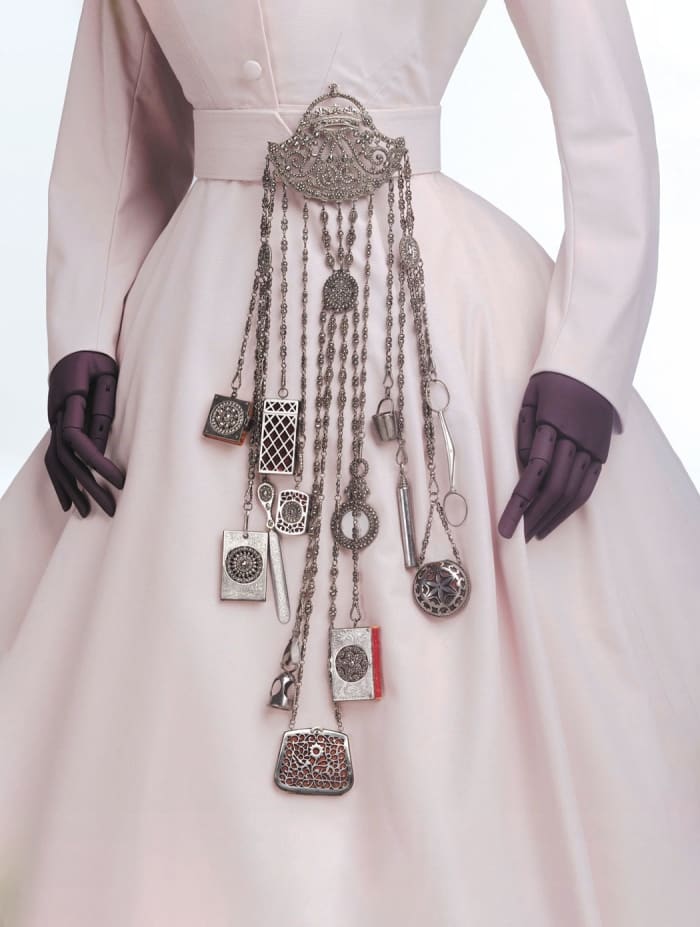
An elaborate cut-steel and ivory chatelaine, circa 1863-65, shown as it would have been worn attached to a dress. Tools include scissors, scent bottle, case, case top, miniature bucket, needle case, possibly a cigar cutter, paper knife or letter opener, writing tablet case, notebook and magnifying glass.
Courtesy Victoria and Albert Museum
Historian Monica F. Cohen writes in Professional Domesticity in the Victorian Novel: Women, Work and Home that the word chatelaine “derives from the medieval word for a castellan or a keeper of the castle or chateau who wore at his or her waist the key to the castle’s various rooms,” and all the cabinets, desks, drawers, and pantries. Having the chatelaine indicated status and power, as this person held authority, had access to the family’s valuables, and had the power to supervise the home’s servants.
“Chatelaine” was officially used as their name in 1828 when the London magazine, The World of Fashion, reported on a new accessory called “la chatelaine.” The new devices included a symbolic key, as the ladies wore them to symbolize their status as “The Lady Chatelaine” of their chateau.
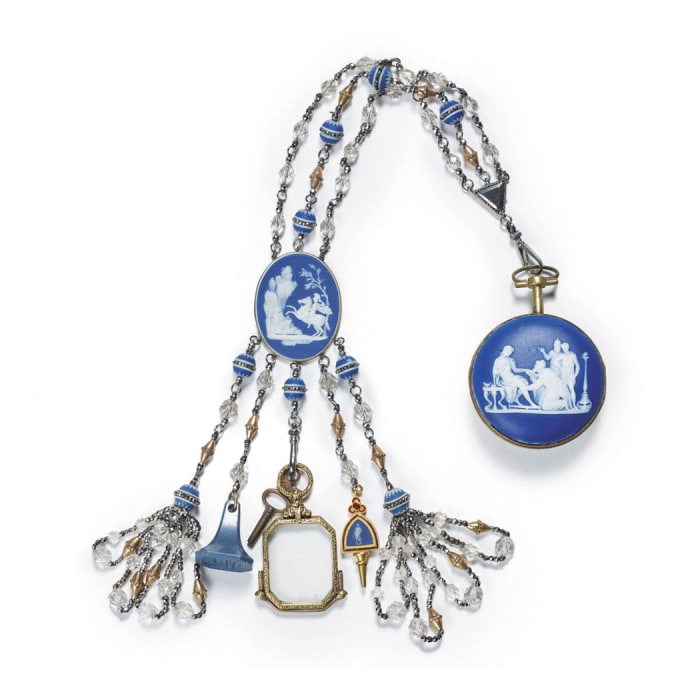
A Wedgwood blue-and-white Jasperware and steel-cut chatelaine, circa 1800, features a watch case and three chains of cut-steel, cut glass and jasper beads with various attachments, including clusters of glass beads, two keys and a seal; 16-1/2” l. This sold at auction for $2,250.
Courtesy of Sotheby’s
Cohen says that their popularity as an accessory in the 19th century was due to a growing Victorian belief in the importance of housekeeping in a woman’s life. All members of society, from maids to royalty, wore chatelaines, and each woman would carry various items specific to her needs.
Besides being beautiful and convenient to wear, a chatelaine announced that a woman had domestic responsibilities and took those responsibilities seriously, says Cohen.
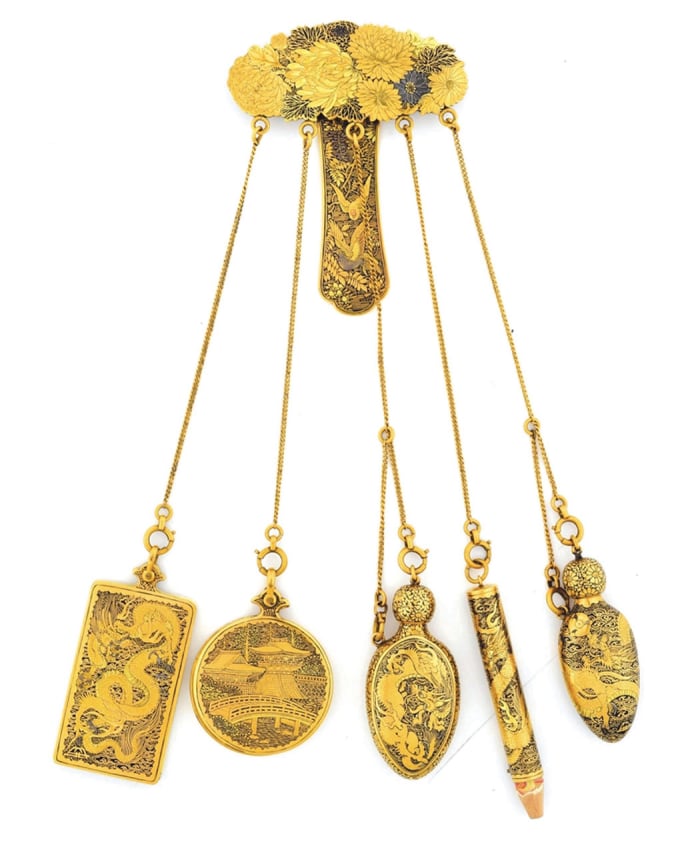
A Victorian chatelaine by Shakuda includes a writing pad, pencil, mirror and two perfume bottles: $6,000.
Courtesy of Morphy Auctions
Renowned jewelers, including Boucheron, Fabergé, Tiffany & Co, and silver manufacturer Gorham, also made luxury chatelaines for society women to show off at fancy dress balls, parties, and other social events.
The chatelaine was so popular that, as with other fads and fancies of passing fashions, it was an easy target for satirists to mock. In two famous cartoons in London’s Punch magazine in 1849, English illustrator John Leech (1817-1864) lampooned the new enthusiasm for the accessory. In one, titled, The Chatelaine; a Really Useful Present, a proud young husband stands by his wife from whose waist hangs an enormous chatelaine equipped with a broom, a carving knife and fork, a kettle, and a chamber candlestick. “Oh! Look, Ma’ dear,” says the young woman to her mother, “see what a love of a chatelaine Edward has given me.” In the other cartoon, How to Make a Chatelaine a Real Blessing to Mothers, Leech shows a woman on an outing at a park with a dog, toddler, and baby carriage attached to the long chains of her chatelaine while she reads a book.
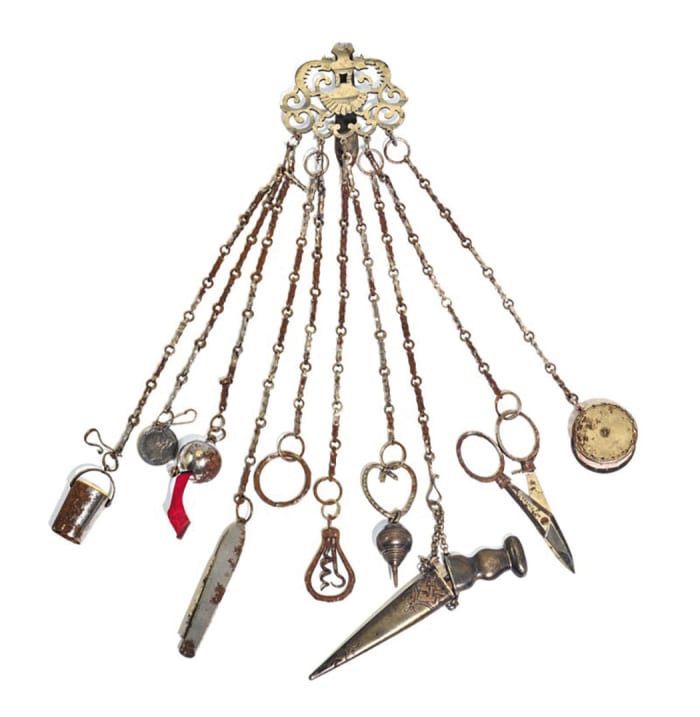
A cut-steel chatelaine, circa 1860-1875, with pierced scroll-pattern head and 10 chains fitted with implements: $1,120.
Courtesy of Sotheby’s
When larger handbags became in vogue, women started carrying their necessities in those, and a lot more of them at that, and the old-fashioned charm of the chatelaine eventually ran its course. Elle Decor reported in 2020, however, that modern interpretations were seen on the runway, and they were supposedly making a comeback.
But even the clanging wore out its welcome. According to Sotheby’s, the woman’s column in a 1911 edition of The Weekly Telegraph featured a finger chatelaine as a novel new trinket, but the columnist wrote that “they made an irritating jingle, which was distinctly trying to the nerves.”
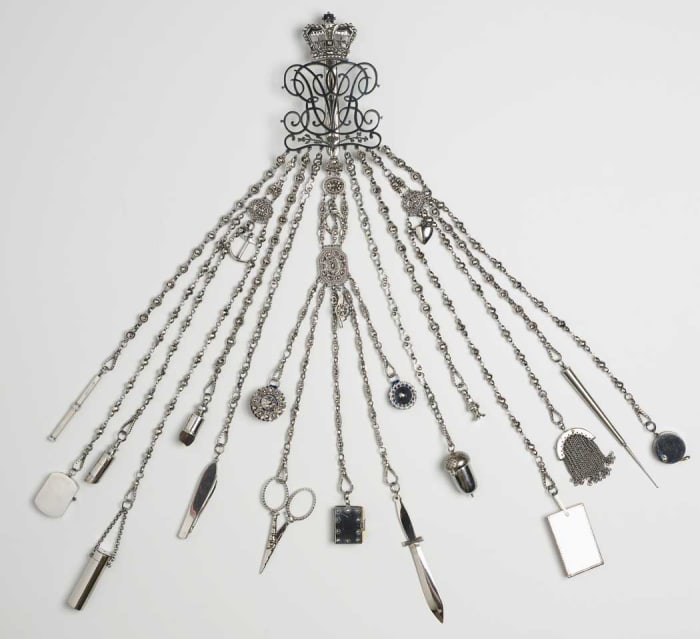
Queen Victoria purchased this significant cut and faceted steel chatelaine in 1850. Some of the items are lined in velvet.
Courtesy of the Royal Collection Trust

